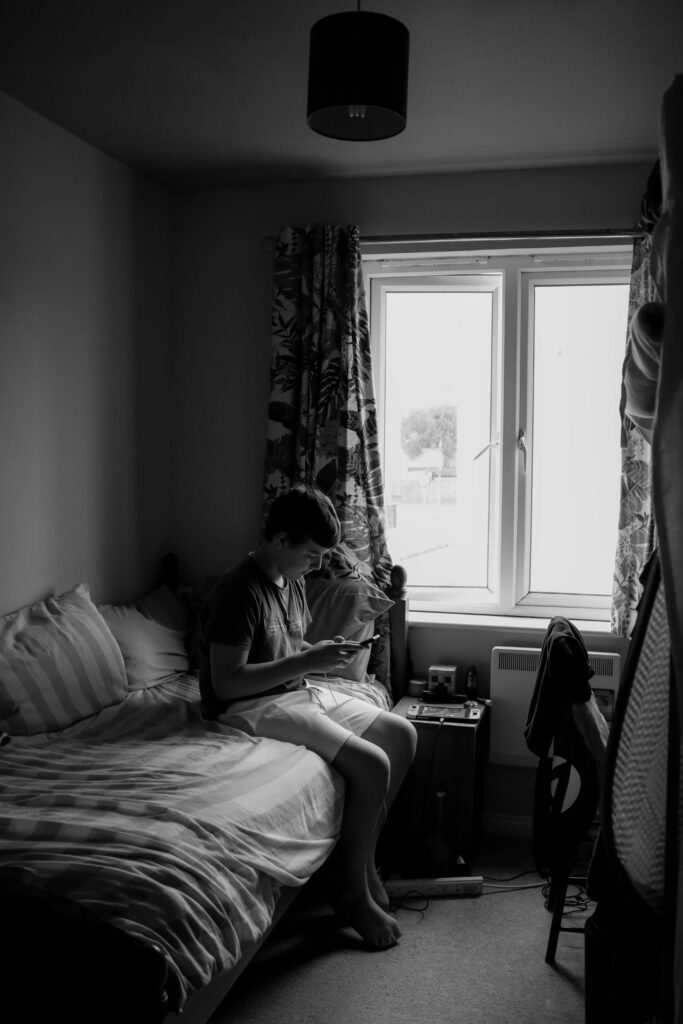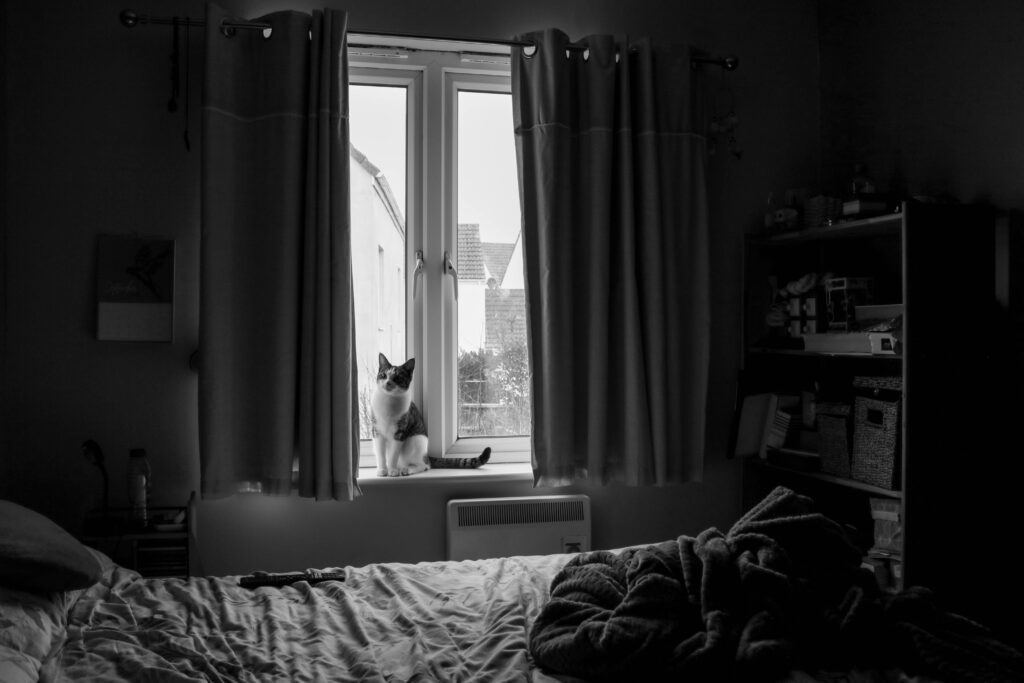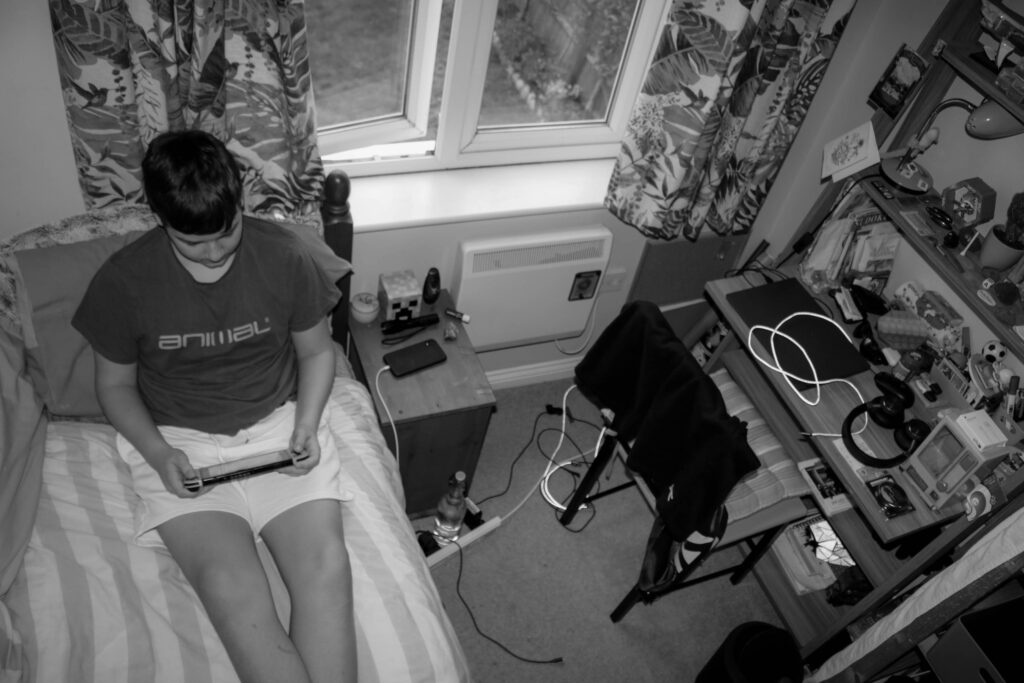This is a link to an online copy of my book: Saudades
All posts by Hannah Fernandes
Filters
Virtual gallery + evaluation
I’ve created a virtual gallery to show how I’d display the outcomes from the ‘Nostalgia’ project.




EVALUATION
MY APPROACH TO IMAGE MAKING:
I captured a combination of photo types; objects, landscapes, and portraits. My approach when making my images was to aim to capture a part of my identity. I did this by creating documentary style images of my family homes in both Madeira and in Jersey. In Madeira, my focus was around things that were familiar to me to show the nostalgic element of what I remember from when I last visited when I was younger. In Jersey, I wanted to capture some portraits of my family which I believe added to my portrayal of myself and identity.
HOW DID I PLAN THIS PROJECT?
As I knew I would be visiting Madeira over the Christmas holiday, I planned on using the opportunity to base the majority of my project on this. I wrote up photoshoot plans in order to help my organise some of the material I wanted to capture.
PHOTOSHOOT AND EDITING:
I planned numerous photoshoots, a combination for both Madeira and Jersey. Upon return to Jersey, I then imported all my images into Adobe Lightroom and began my selection process. Then editing my selected images for outcomes to present in my photobook.
WHAT WENT WELL IN THIS PROJECT?
I’ve created successful outcomes for the project theme ‘Nostalgia’ and created a photobook to display these photographs in a physical form.
WHAT COULD HAVE USED IMPROVEMENT?
To improve this project, I could have captured some more portraits of my family in Madeira. Some more formal portraits where I get them to face the camera could have improved the strength of the portrait aspect of my photographs. Some additional landscape or object photographs in Jersey could have balanced out the book slightly, as I felt it was slightly sparse on that end when organising the photobook.
FINAL PRINTS: Mounting + Presentation
I have selected some of my final images to be printed so that I can frame them. This gives me another physical outcome to provide evidence from this project. These are the photos I have selected:
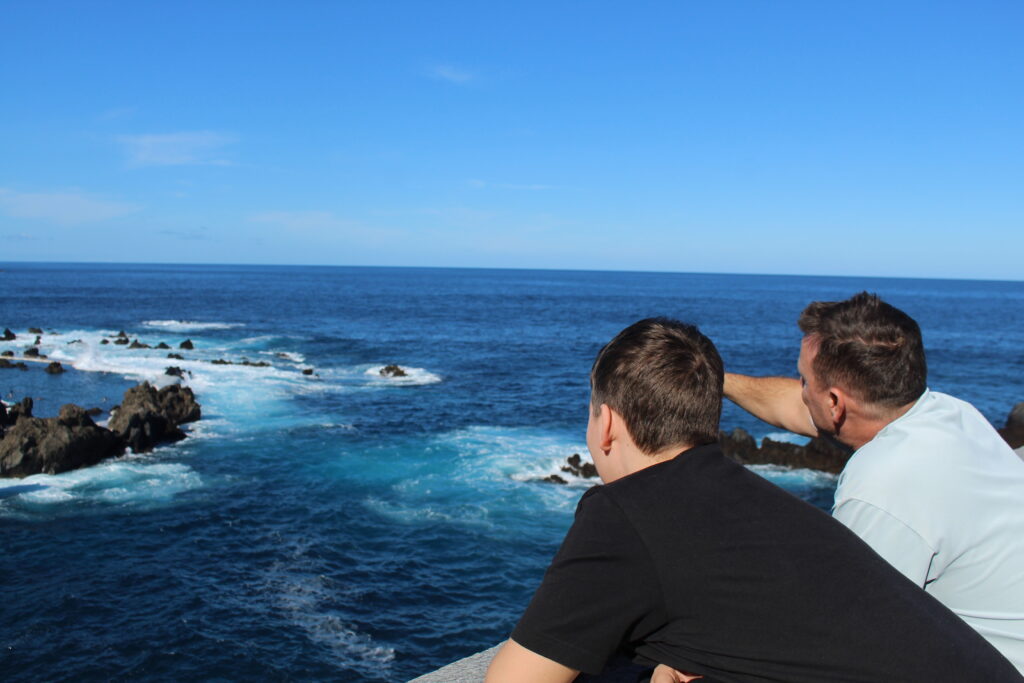



I have used photoshop to help me plan mock ups of how I want to present my images when framing them. I have organised this into a total of 2 mock ups as I didn’t send many photographs for printing.
1

I liked the idea of this photograph being a stand alone image. So I had it printed in A3, and will be framing it as a window mount. I think this is a strong image which beautifully captures the pools of Porto Muniz, as well as my dad and brother admiring the view. I think the black with perfectly contrast the colours of the photograph and make the blues even more vibrant, opposed to a white foam board.
2

For this sequence, I’m combining two A5 prints (top) and one A4 print (bottom). I think these images compliment each other well, all being black and white and of similar subject matter. The bottom image is one I captured of my grandparents’ living room, and the top two images are those I captured in other family homes. I will put each photo on an individual piece of foam board, and then use an additional piece of black card to combine them.
ESSAY
In what way have Latoya Ruby Frazier and Alessandra Sanguinetti explored the notion of family history and childhood memories as a method of understanding identity and self-expression?
“Photographed images do not seem to be statements about the world so much as pieces of it, miniatures of reality that anyone can make or acquire.”
Sontag, S (1977), On Photography. London: Penguin Books
Photographs are a way of documenting and capturing moments in time to preserve them. This quote by Susan Sontag highlights, how although this definition is true, photographs cannot always capture the whole truth. Capturing special moments with photography to look back on allows us to gift ourselves a nostalgic feeling. So, in my project, when revisiting elements of my childhood and family, I will thus be creating a nostalgic feeling for myself. Although I cannot recreate these special memories, I can show aspects of what my childhood was like as well as expressing certain emotions through my work. My project is focussing on my childhood and upbringing, while also acknowledging my heritage. I want to do this as I believe this will communicate a sense of self. By taking inspiration from previous projects (home, identity, etc) I will be taking portraits of family and photographs of significant objects, as well as occasional landscapes. My personal study will explore my dual nationality, portraying both my English and Madeiran heritage from each of my parents.
I will be comparing the works of artists Latoya Ruby Frazier and Alessandra Sanguinetti. During my research, I found that I liked their styles of photography. They both capture inspiring photographs of their family, creating a combination of both classic and environmental portraits. Latoya Ruby Frazier’s work is typically in black and white which I arguably find more incising and meaningful. By stripping a photograph of its colour, it allows the viewer to gaze more deeply into it and its potential meanings and story being presented. She also captures occasional objects and landscapes in her work which are significant to her and her story. Whereas Alessandra Sanguinetti’s work is predominantly in colour, expressing life and emotion through her photographs. Both artists create a mixture of both documentary and staged images. I wish to compare these artists throughout this essay while addressing themes of identity and self-expression. By studying these artists, I can explore how childhood memories influence these themes and allow myself to explore this throughout my personal study project.
I created a collection of photographs while in Madeira over the Christmas holidays, capturing familiar landscapes from trips when I was younger, like family homes for example. I also captured few pictures of family, street photography, environmental portraits, etc in a documentary-type style. Originating in the 19th century, documentary photography is said to “show, in an informal way, the everyday lives of ordinary people and the photographer’s goal was to bring the attention of an audience to the subject of his or her work”. This is an effective method of photographing this part of my life, in Câmara de Lobos. This is because it communicates to the viewer that I am documenting part of my family heritage as an attempt at self-expression and to explore my childhood memories of being with family in Madeira. I conducted some more photoshoots upon returning to Jersey; trying to capture the family I have on island. However, although some images were documentary, I captured these portraits in a tableaux style. Tableaux photography offers a “much more oblique and open-ended description of something that we know is significant because of the way it is set up in the photograph”. This was important to me because while I care for my family in Madeira, I do not see them as often as my family in Jersey. Therefore, through tableaux style photography, I captured photographs of my family to portray how significant they are to me and how they have shaped me as a person. It was also to show that I have an element of control over my life currently and can shape future memories but cannot manipulate past childhood memories. By creating a photobook for my project, it allows me to establish a storyline throughout the series of images and show the progression of my life between these two places significant to me. I have divided the images with occasional double page spreads which add a pop of colour to my photobook. One significant photograph is one of the natural pools in Porto Moniz, which I used to signify me travelling across from Jersey to Madeira which demonstrates the separate aspects of my life. I have also incorporated other themes like religion, which is especially important to my grandparents. This will create the story of my identity, showing my family, to capture the essence of having my dual heritage.
Latoya Ruby Frazier uses her work as a vice to preserve ideas of labour, gender, and race in aspects of industrialism. Her first publication ‘The Notion Of Family’ aimed to portray how she, as well as her mother and grandmother, survived environmental racism in her hometown of Braddock, Pennsylvania. By focussing on her hometown, Frazier addresses childhood memories through her work. She reflects upon her life through these images to share a personal and potentially sensitive aspect of her life. This communicates an aspect of her identity to viewers as well as an element of self-expression through her work. She took inspiration from Gordon Park’s idea of using a camera as a “weapon” against racism, showing how her use of documentary and tableaux photography methods have created a collection of influential images. Frazier offers an insider’s perspective into her chosen topics of race, industrialism, and more. Opposed to an outsider’s perspective which arguably holds elements of depthlessness, anonymity, banality, and mechanical reproducibility. An insider’s perspective allows the photographer to deeply connect to their work and to create better outcomes altogether. In addition, because her own family was part of her project ‘The Notion Of Family’ and it was a reflection of herself, it allowed her to give her photographs a deeper meaning and understanding. The process of image making is also a lot more effortless as the subjects become comfortable in front of the lens when having a close, trusted family member creating the images.


Alessandra Sanguinetti aims to capture the essence of youth, and therefore nostalgia in her work. This is portrayed through her project ‘The Adventures of Guille and Belinda and The Enigmatic Meaning of Their Dreams’ which follows the cousins Guille and Belinda through the countryside of Buenos Aires. This project was created through an organic process, meeting Guillermina and Belinda’s grandmother through her family’s farm and in their surrounding area. Sanguinetti knew the pair of cousins since they were around 4 years old. Her initial intention was to focus the subject matter upon animals on the farm, however this shifted in 1988 when she decided to include the girls in her image making upon discovery of a story within them. Though they are not family, this relationship of knowing someone for many years creates a sense of comfort. This allows Sanguinetti to capture these portraits naturally among the farm, which is their natural born home. She did not predict the nature of the project, not expecting it to develop into a series through time, emphasising the natural and organic nature of her work. Through reflection of her project, Sanguinetti realised the importance of having a larger perspective and being able to view the whole story. In my own project I took some inspiration from her approach, naturally capturing images through documentation of Madeira. My lack of plan for the landscape photography aspect of my photographs allowed me freedom to capture anything eye-catching or mundane within the streets of Câmara de Lobos. Like Sanguinetti, by exploring this Portuguese aspect of my identity it allowed me to create documentation of Madeira, creating a series of images which reflect my identity as a whole. These photoshoots I conducted allowed me to produce successful outcomes to make a photobook which creates a story. Sanguinetti talked of how if you look at something very closely, you will see a lot of points which don’t make sense. This project has allowed me to create a photobook which evidently shows a part of me and my life through my establishment of timeline and self-exploration.
In Conclusion, this project has allowed me to create a personal exploration of my childhood, family, and heritage. Through the lens of both documentary and tableaux photography styles, I sought to capture important memories and emotions tied to my upbringing, ultimately expressing my identity. Similar to Frazier’s focus on identity and Sanguinetti’s emphasis on nostalgia, I aimed to create an outcome which reflects the duality of my English and Madeiran heritage. The process of creating this project has allowed me to not only document my family’s history and significant moments but also to explore how these memories have shaped my sense of self. Incorporating elements of both black and white and colour photography, I aimed to reflect an emotional response like in these artists’ works. Similarly to Frazier and Sanguinetti, I have explored my own experiences and successfully created visual representation of my own heritage, presenting a story that demonstrates the importance of preserving our memories.
BIBLIOGRAPHY
Döblin, A (2003), August Sander: Face of Our Time. Munich: Schirmer Art Books.
Sontag, S (1977), On Photography. London: Penguin Books
https://latoyarubyfrazier.com/
https://archive.nytimes.com/lens.blogs.nytimes.com/2014/10/14/latoya-ruby-fraziers-notion-of-family/
https://www.photopedagogy.com/uploads/5/0/0/9/50097419/week_5_abigail_solomon-godeau_inside_out.pdf
https://www.newyorker.com/culture/photo-booth/off-the-shelf-the-adventures-of-guille-and-belinda
PHOTOBOOK: Final layout and evaluation



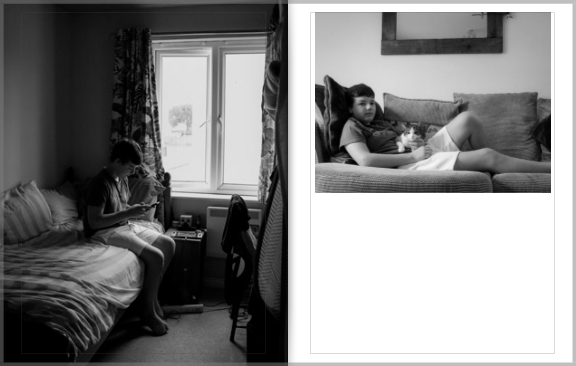

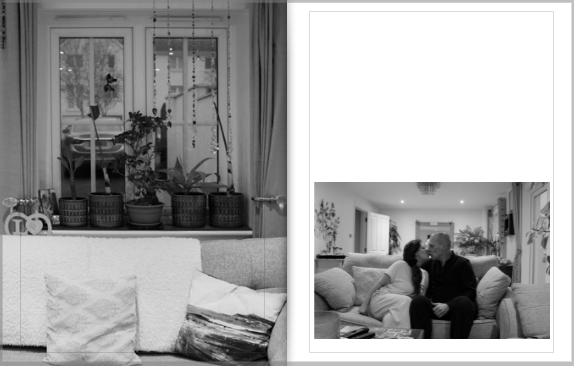

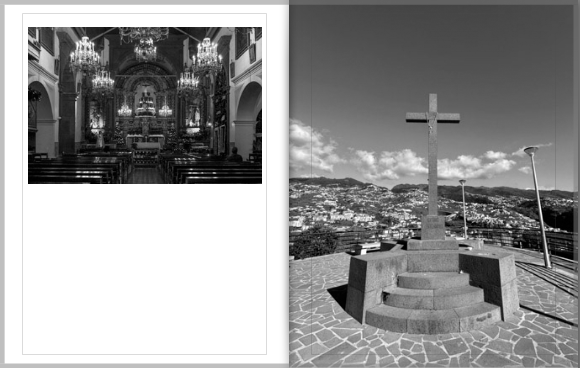

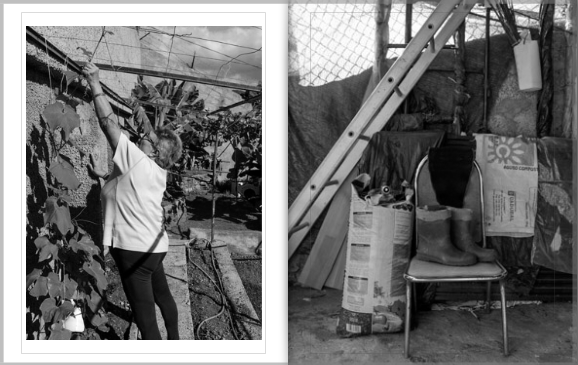
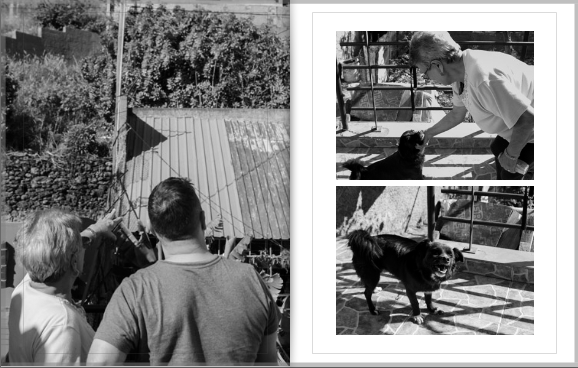





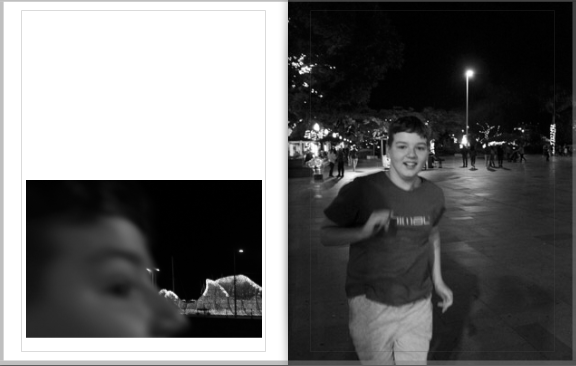
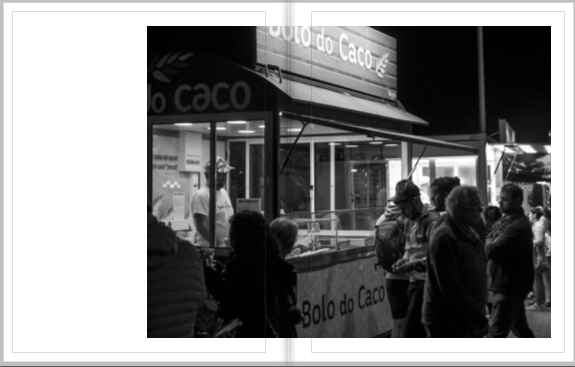


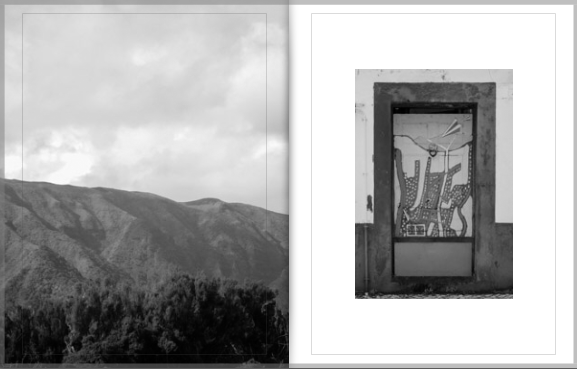




EVALUATION
The process of making a photobook was a new concept to me, as I had never created one before. However I found it to overall be quite straightforward, as there are templates to aid you in formatting choices. Once I had edited all my images, I selected my favourite outcomes and created a new collection set named ‘Photobook’ which allowed me to organise my images.

This template function offers numerous formats for each page. Allowing me to carefully align all the images evenly on every page. The process of making the photobook was also aided by guidance from teachers who already had previous experience with this software. They offered advice on formatting choices which allowed me to establish storyline across the entirety of the book.
Overall, I think my project has been successful in portraying my interpretation of the theme ‘Nostalgia’. I’ve created a storyline across the book. Starting with a family tree to establish the message of the book is focused on family and heritage, as well as the incorporation of archived images from my childhood. I’ve created documentation of my family across both Jersey and Madeira, creating mostly black and white images of people and landscapes as I planned. I believe the seperation between Jersey images and Madeira images has been successful in representing the divide between the dual parts of my heritage, and those seperate aspects of my identity. What could have used improvement is the amount of portraits I took of family, as that was the main focus of the project.
PHOTOBOOK: Research + Analysis

Subject-matter: Her book explores racism and economic decline in America’s small towns, as shown in her hometown of Braddock, Pennsylvania. She portrays the hardships of Frazier’s family, who grew up there, through her images. She has included a selection of photographs; landscapes, portraits, and objects. She particularly focuses on photographs of herself and her family.
These are some of the images in her book:




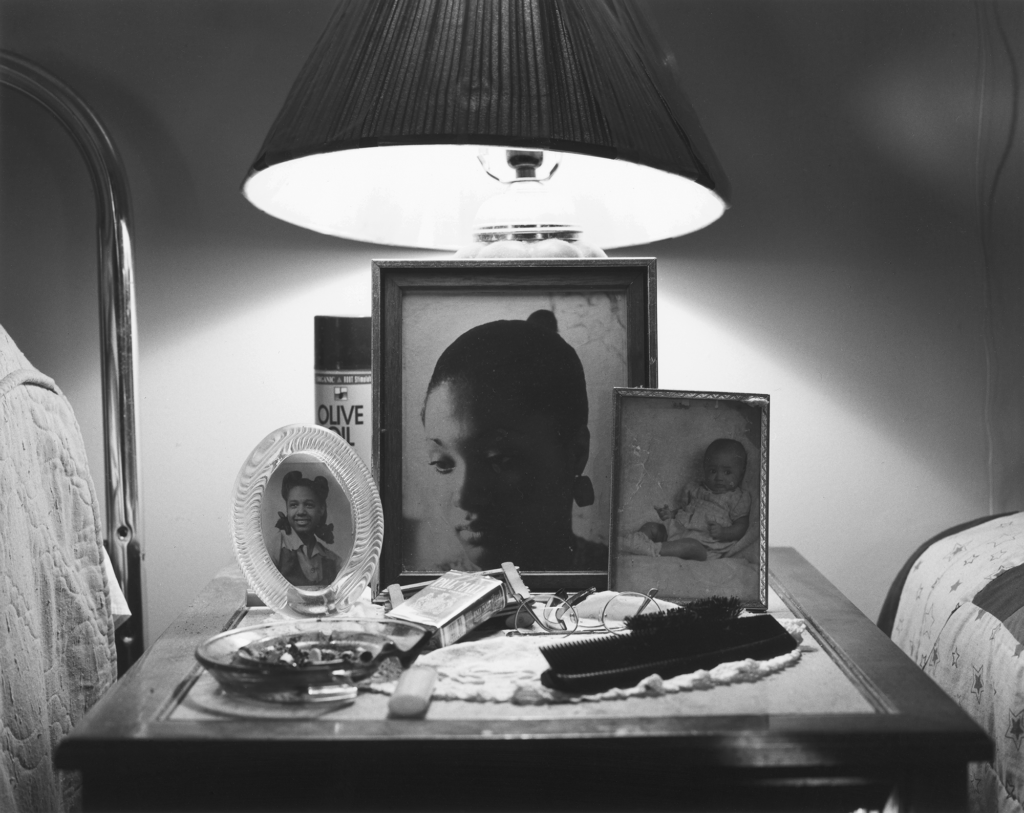
Genre: In her work, Latoya Ruby Frazier aims to document the decline of her hometown. This is created through the use of documentary photography and capturing landscapes of Braddock i.e., buildings among the town. She also combines this with an element of staged images of her family, capturing the personal element and effect the decline has had on herself and her family.
Approach to image-making: Frazier uses black and white film to capture her domestic portraits. She uses photography as a way of making substantial differences, capturing images to address important issues just like in this book ‘The notion of family’. Capturing medium format images in documentary and tableau style elements.
PHOTOBOOK: Narrative + Story
1. Write a book specification
Narrative: What is your story?
Describe in:
- 3 words
- Documentation of family.
- A sentence
- Creating documentation of my feeling of nostalgia through childhood memories.
- A paragraph
- Creating a documentation of what I find nostalgic through exploring my heritage and nationality. I am taking photographs of family and landscapes in both Jersey and Madeira. This is to recreate childhood memories and portray my family story in the form of a photobook.
Design
How you want your book to look and feel: I want my photobook to have a storyline. I want it to look like a documentation of my family, and I want the divide between my life in Jersey and my life in Madeira to be clear. I photographed the natural pools of Porto Muniz, which I want to include as a double-page spread in my book. This will be used as a metaphor for travelling across from Jersey to Madeira, creating this divide and separating the images.
Paper and ink: Hardcover book with premium paper and lustre finish
Format, size and orientation: Standard portrait format (20cm x 25cm)
Title: I wanted to choose a Portuguese word for my title, as my book is mostly consisting of photographs I’ve taken in Madeira of my family and family home. I’ve chosen the word Saudades as it refers to a feeling of melancholic longing. I thought this fit with the nostalgia theme as ‘nostalgia’ also refers to a longing, but of the past. This is to communicate how I miss my family in Madeira as well as the island itself.
2. Produce a mood-board

Archive
I gathered some photographs from personal family archives. I want to incorporate some of these photos into my photobook, fitting into the ‘nostalgia‘ theme through reflection upon my childhood.




There are some other old photographs I found; photobooth and passport pictures. These photobooth photos are of my mum and dad in their childhood. I thought these might be good to incorporate into the photobook as it shows where I’ve come from, as well as where my dual nationality stems from. I imported them into Lightroom so I could adjust the pictures and edit the contrast.



These are some passport photographs I have gathered of my nana, mum, dad, brother, and myself. I like these as they’re a more standardised portrait where you can clearly see the person’s face. I want to incorporate these into my photobook so I could construct a family tree of photos. I’ll put this on the cover of the photobook or one of the first pages. This is to establish the storyline and shows how the subject of my book is on my family. These are the final pictures I’ve chosen to use for my photobook:





PHOTOSHOOT 4
I wanted more photos of my family here in Jersey as my original aim was to capture portraits of family members. My family in Jersey is very limited, so I took pictures of my Aunt and Uncle. My Aunt is from my dad’s side of the family, showing some more of my Portuguese heritage.
SELECTION PROCESS
RATING CODE:
RED – Bad quality images
YELLOW – Average images
GREEN – Good images
BLUE – Best outcomes which I can use for the photobook


EDITING PROCESS

After the process of selecting the images, I edited my best outcomes. I made these black and white to fit with the rest of my book, creating standardisation across the series of images.
PHOTOSHOOT OUTCOMES





This was a successful photoshoot which produced outcomes for which I can use in my photobook to bulk up the Jersey-side of the book.
PHOTOSHOOT 3
SELECTION PROCESS
RATING CODE:
RED – Bad quality images
YELLOW – Average images
GREEN – Good images
BLUE – Best outcomes which I can use for the photobook
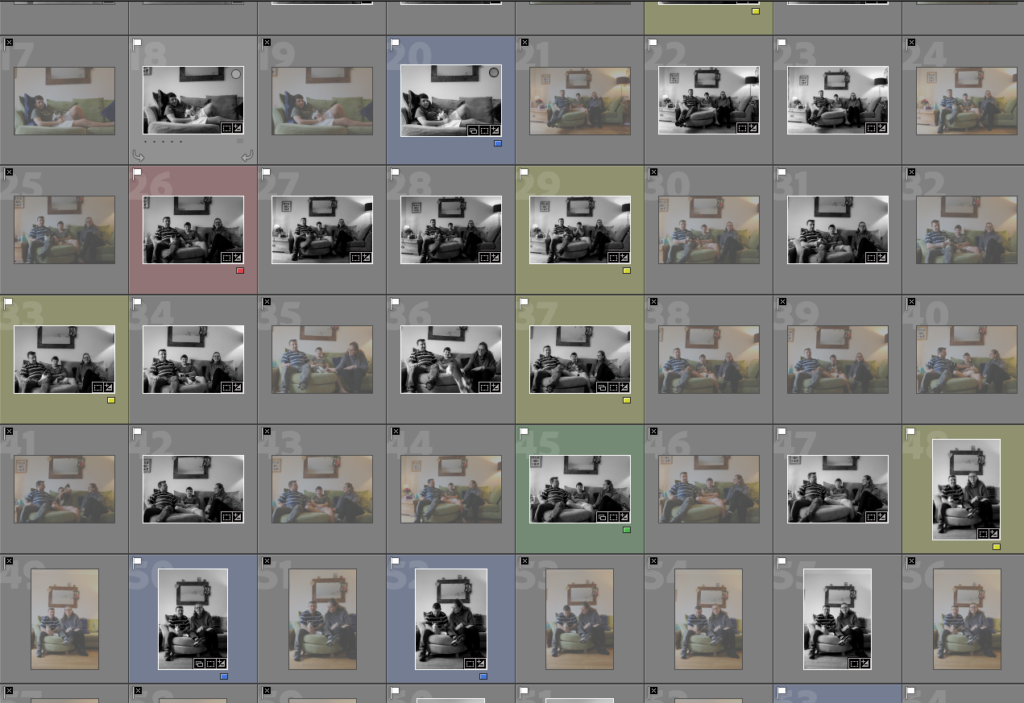
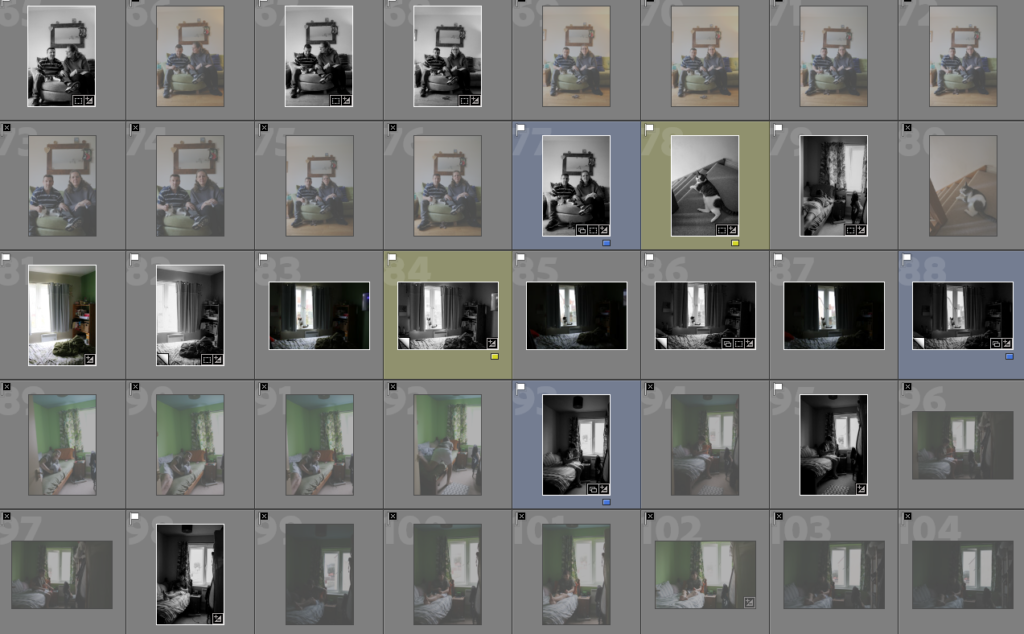
EDITING PROCESS
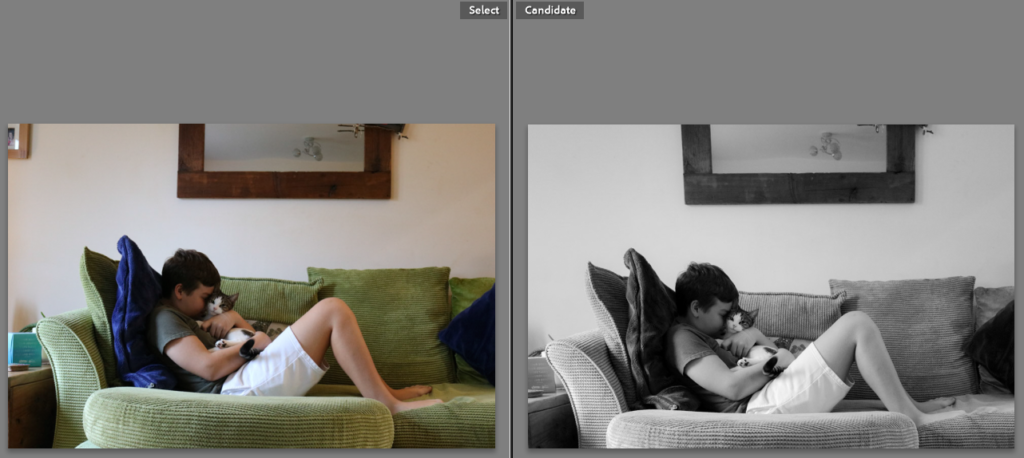
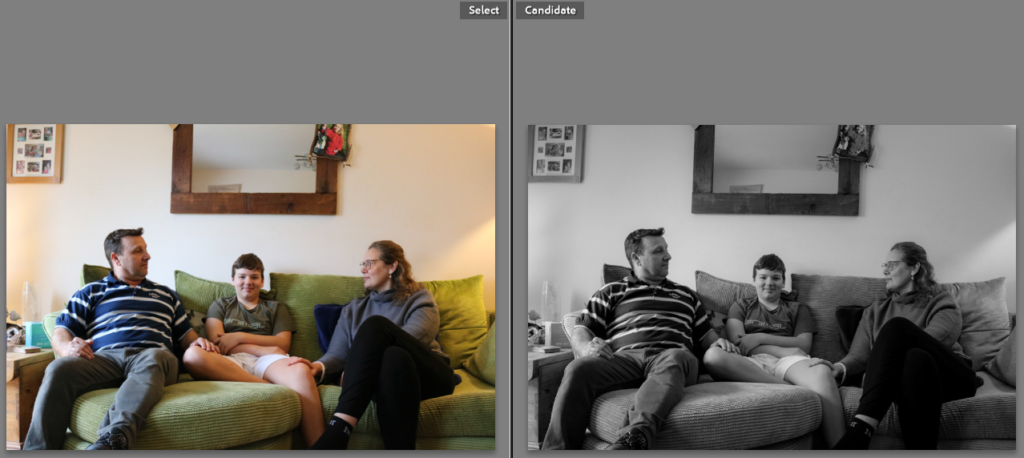
PHOTOSHOOT OUTCOMES



